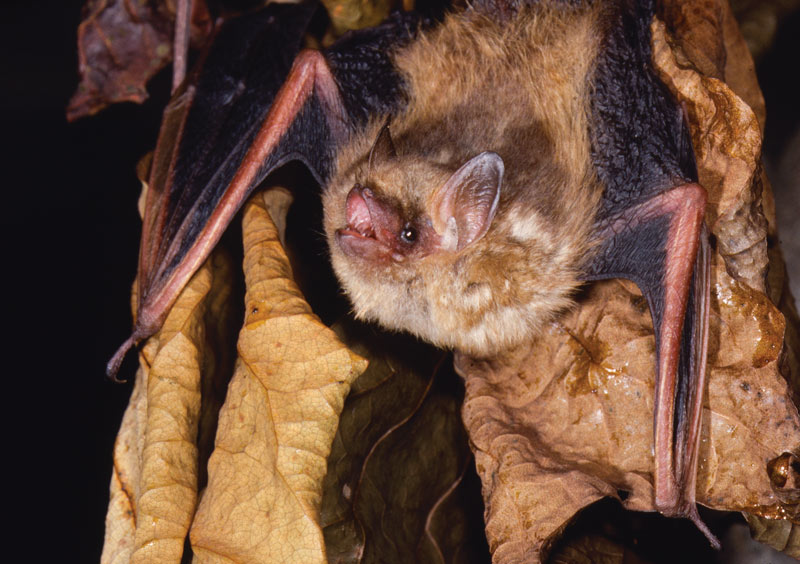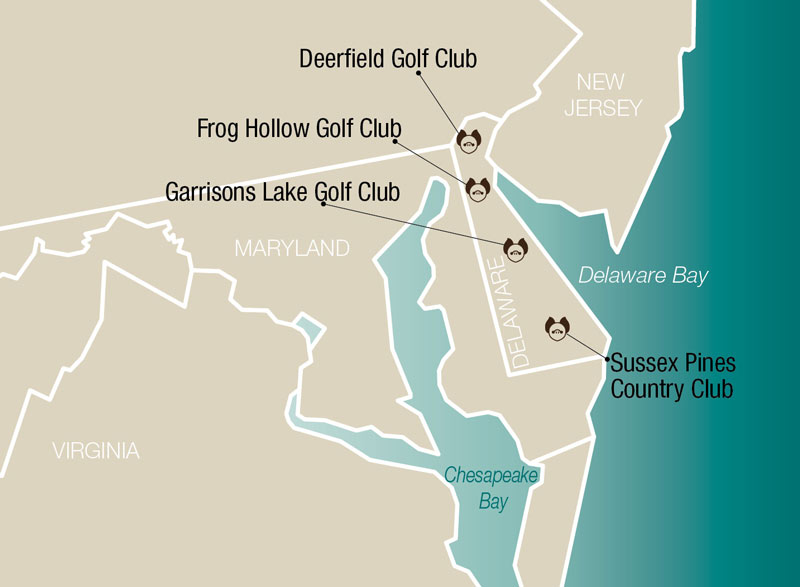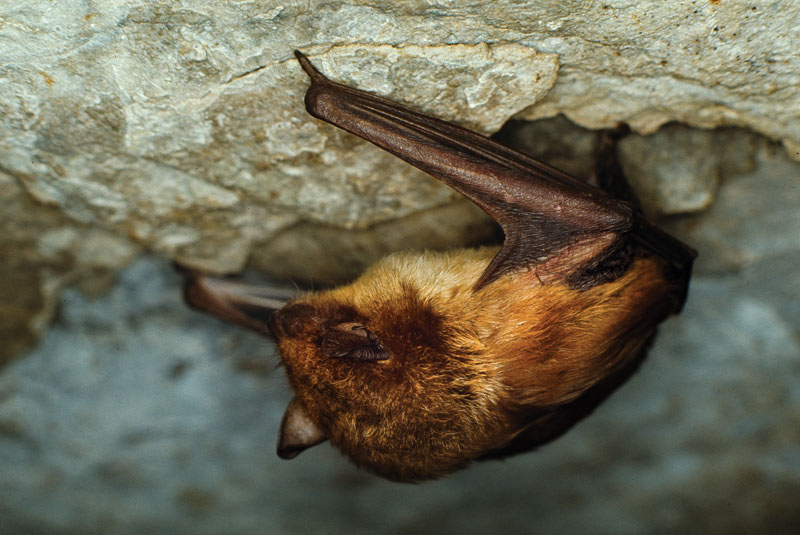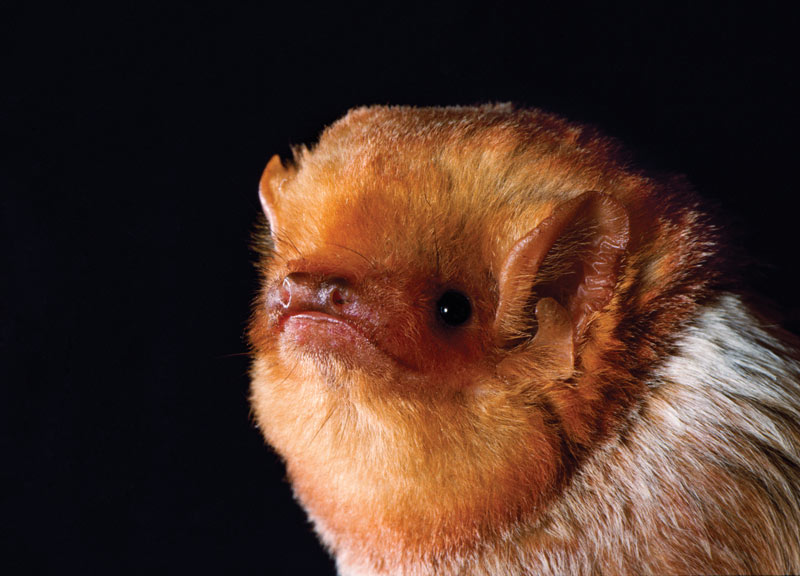
A roosting tri-colored bat (Perimyotis subflavus). These bats are named for their distinctive coloration — each hair has three colors: a brown tip, a yellow middle and a dark base. Photos by Merlin Tuttle
Golf courses offer a park-like atmosphere with landscaping, stands of trees and water features — and often offer a green island in an urban area — that may be as attractive to wildlife as it is to people. Increasing pressures from habitat loss and fragmentation continue to threaten wildlife across the globe, but as green spaces, golf courses have the potential to play a key role in conserving biodiversity.
The capacity of golf courses to serve as wildlife habitat needs to be evaluated on a species-specific basis, because life-history traits and habitat needs vary widely among species (8). Studies have shown that golf courses are able to support several species of wildlife, even those that may be threatened or endangered (4, 5, 12). Compared with other anthropogenically disturbed habitats, golf courses are more valuable to wildlife (3). Although many bird, reptile and mammal species have been studied in the context of golf courses, little attention has been focused on bats.
Bats: A bit of background
Bats are a diverse group of volant mammals, with over 1,200 species worldwide. Within the United States, there are 47 species with diverse life histories. Depending on the species, bats can form colonies — consisting of small groups to millions of bats — or roost alone in caves, trees, foliage, bridges, attics, bat boxes or other man-made structures.
The majority of bats in the U.S. are insectivorous and are the primary predators of night-flying insects (1), providing critical pest control services throughout their range. This important ecological service has been estimated to be worth up to $57 billion annually to the agriculture industry alone by reducing the number of pests and the presence of pest-associated fungi (2, 10). Bats have also been considered indicators for ecosystem health.
Bat conservation has become a top priority for many conservationists, as bat populations are declining because of habitat loss and fragmentation, disease, and wind energy development. The landscape features found on golf courses may provide habitat attractive to bats and could offer golf courses a unique opportunity to contribute to bat conservation.
Bats on golf courses
While buildings, bunkers, tees, fairways and greens make up 40% of the average golf course and likely do not provide adequate food, water or shelter for wildlife, the remaining 60% of a golf course has features that offer a matrix of habitat types that may be attractive to bats (6).
Trees along the edge of a fairway create the hard tree-line edge that bats have been shown to prefer, as these create protected corridors for safe commuting and successful foraging (11, 13). Water hazards can provide drinking water and sources of insect prey for bats. Forest patches found on courses may contain trees that are suitable for bats to roost in during the day. These features and observations suggest a high likelihood that bats will use golf courses for roosting and foraging. However, no study had quantified bat activity or habitat use on golf courses to date.
Study: Bat activity on golf courses in Delaware
To begin to understand bat activity on golf courses, in 2011, four golf courses in Delaware were chosen for a study of the effects of small-scale golf course landscape variables on bat activity (Figure 1, below). Five visually distinctive small-scale habitats were identified that were represented on all courses: dense understory-natural, open understory-natural, water hazard, open grass, and open understory-managed (Table 1). To capture peak summer bat activity, research was carried out during June and July. One golf course was visited per night, and specialized acoustic monitors that record ultrasonic echolocations of flying bats were placed at each of the five small-scale habitats for a total of six nights per golf course.

Figure 1. Location of the four golf courses where the study occurred.
After the acoustic data were collected, the recordings were analyzed using SonoBat, a software that parameterizes and identifies echolocation calls to species. Each recording was classified as a “bat pass.” Additionally, when bats feed, they emit a “feeding buzz,” a rapid set of echolocation pulses that can be visually distinguished on spectrograms. Feeding buzzes indicate foraging activity. Three metrics were quantified: total bat activity (total number of bat passes per recording night); foraging activity (total number of feeding buzzes per recording night); and species-specific activity (total number of bat passes from each species). Effects of habitat on each metric were analyzed. This study did not compare activity with that in similar habitats on non-golf course sites.
Overall bat activity and foraging activity
Of the eight species of bats found in Delaware, six species were found at all four courses and in all habitats: Eastern red bat (Lasiurus borealis), hoary bat (Lasiurus cinereus), big brown bat (Eptesicus fuscus), little brown bat (Myotis lucifugus), tri-colored bat (Perimyotis subflavus) and evening bat (Nycticeius humeralis).

One of the largest bats found in North America, the big brown bat (Eptesicus fuscus) has a range that extends from Canada and the U.S. to Central America, the Caribbean, and south to Colombia and Venezuela.
Significantly more overall bat activity (6,899 total recorded bat passes) and foraging activity was recorded in the open understory-managed habitats than in the other habitats that more closely reflected natural habitats (dense understory-natural, open understory-natural, and open grass) (Table 2). Overall bat activity was also higher at water hazard habitats than in natural unmanaged forest patches and open grass areas. Based on these results, bats used the open understory-managed habitats and water hazards more frequently for commuting and foraging than they did the other habitats studied.
Maintaining stands of large-trunked trees with an open understory and closed canopy provides protected flight corridors for bats as they travel and feed. Ensuring proper pesticide and fertilizer application to minimize runoff into water sources will also continue to provide clean drinking sources for bats.
Species-specific activity
Forty-seven percent of all recorded calls (6,899) were identified to a species. Six of the eight bat species that occur in Delaware were detected across all habitats and most golf courses: big brown bat, red bat, evening bat, hoary bat, tri-colored bat and little brown bat. Big brown bats and red bats were the most often identified species in the data set. The two species not detected, northern long-eared bat (Myotis septentrionalis) and silver-haired bat (Lasionycteris noctivagans), are uncommon in the Delaware landscape.
Habitat influenced some species-specific activity. Big brown bats and red bats had higher activity levels in the open understory-managed habitats (Figure 2). There was a trend of higher activity of evening bats in open understory-natural and managed habitats. There was no significant effect of habitat on other species identified on the golf courses. The lack of effect may have been due to small sample size.
The dominance of red bats and big brown bats across all habitats suggests they may be more commonly detected or are more abundant in the landscape. Physical capture of bats corroborated their abundant presence, as most of the captures were of those two species (data not shown). Alternatively, the high numbers of red bats and big brown bats could indicate that they are better suited to use altered landscapes.
Promoting bat diversity on golf courses
Though not specifically addressed in this study, the different bat species have diverse life-history traits and different habitat needs. To promote bat biodiversity on a golf course, superintendents need to maintain a more heterogenous landscape that will offer a variety of landscape features that are attractive to multiple species.
Native vegetation attracts non-pest native insect communities, of which bats are natural predators. During the breeding season, female bats can eat almost their body weight in insects (9). Additionally, bats are important predators of mosquitoes and thus contribute to human comfort and safety.

The Eastern red bat (Lasiurus borealis) eats insects and seems to prefer moths, including pests such as gypsy moths, tent caterpillar moths and cutworm moths.
Besides using golf courses for commuting and foraging, bats may also find roosting habitat on the courses. Leaving dead trees that do not pose a safety hazard can provide roosts for small bat colonies or solitary bats. In southern climates, bats can roost in Spanish moss or palm fronds, and leaving these intact will increase roosting options for bats in the area. The federally endangered Florida bonneted bat has been documented roosting in a tree on a golf course in Florida (7). In addition, installing bat boxes on the course can provide alternative roosting sites (see “Bat boxes on golf courses” below for more details).
The take-home message
Though small in scope, this study is the first to examine bat activity on golf courses and serves as a first step in understanding bat habitat use in these altered landscapes. Golf courses already contain many features that are attractive to bats. Enriching these features by providing improved commuting, foraging and roosting habitat will increase the likelihood of bats calling golf courses home. More bats in an area can provide valuable pest control services and can be an indicator of a healthy ecosystem. Maintaining a diverse landscape on a golf course will appeal to wildlife and golfers alike.
Funding
The Delaware golf course study was funded by a grant from the National Fish and Wildlife Foundation and Delaware State University.
Acknowledgments
The information presented in this article was originally published in a thesis as part of a master’s degree program at Delaware State University (Dover, Del.) under Kevina Vulinec, Ph.D. The full thesis text can be found at https://pqdtopen.proquest.com/doc/2240033877.html?FMT=ABS.
Bat boxes on golf courses
Installing bat boxes or houses can be an easy way to provide roosting habitat for bats. Bat boxes come in a variety of shapes and sizes that can hold hundreds to hundreds of thousands of bats. Knowing the species that occur in your area and understanding which species will likely occupy your bat boxes can help you decide what type of box to install.
Typically, all bat boxes are erected on poles or posts at least 20 feet (6 meters) above the ground, which protects them from predators on the ground and allows for a clear flight path in and out of the box.
Bat boxes feature “landing strips” that are rough surfaces at the base of the boxes that facilitate easy landing. The interior of bat boxes should also have rough surfaces so bats are able to cling to the box wall while roosting. Using materials like hardware cloth or plastic mesh is generally advised against because these may cause injury.
Bats like roosts that are warm, so placing bat boxes in a sunny area is important. Many bat boxes are dark brown to increase thermal radiation, but boxes in warmer climates may need to be lighter in color or have additional ventilation.
Placing bat boxes near water or forest edges — but away from tree branches (where predators may perch — may increase the chances that bats will find and use the box. Boxes should be placed away from particularly busy areas to reduce disturbance to the bats and to minimize human/bat interactions.
Bats may occupy the box almost immediately, or it may take months or years. Some bat boxes are never occupied. If this is the case, try changing the position or location of the box. Placing guano at the base of a newly installed bat box has not been shown to increase the chances of occupancy.
A wide variety of online resources are available to help you choose the best bat house for your location. Here are two you may find useful:
Merlin Tuttle’s Bat Conservation: Selecting a quality bat house
Bat Conservation International: Bat houses
The research says ...
- Open understory-managed habitat and water hazards were used more frequently by bats than the other habitats studied.
- Big brown bats and red bats were the two most dominant species detected on Delaware golf courses.
- Bats are important predators of mosquitoes and other insects and thus contribute to human comfort and safety.
- Providing improved commuting, foraging and roosting habitat for bats may increase species diversity.
Literature cited
- Anthony, E.L.P., and T.H. Kunz. 1977. Feeding strategies of the little brown bat, Myotis lucifugus, in southern New Hampshire. Ecology 58:775-786.
- Boyles, J.G., P.M. Cryan, G.F. McCracken and T.H. Kunz. 2011. Economic importance of bats in agriculture. Science 332:41-42.
- Colding, J., and C. Folke. 2009. The role of golf courses in biodiversity conservation and ecosystem management. Ecosystems 12:191-206.
- Cornell, K.L., C.R. Kight, R.B. Burdge et al. 2011. Reproductive success of eastern bluebirds (Siala sialis) on suburban golf courses. The Auk 128(3):577-586.
- Failey, E.L., J.C. McCoy, S.J. Price and M.E. Dorcas. 2007. Ecology of turtles inhabiting golf course and farm ponds in the western Piedmont of North Carolina. Journal of the North Carolina Academy of Science 123:221-232.
- Golf Course Superintendents Association of America. 2017. Land-use characteristics and environmental stewardship programs on U.S. golf courses. Golf Course Environmental Profile. Phase II, Volume IV. GCSAA, Lawrence, Kan. (https://www.gcsaa.org/docs/default-source/Environment/phase-2-land-use-survey-full-report.pdf)
- Gore, J.A., M.S. Robson, R. Zambrano and N.J. Douglass. 2015. Roosting sites of a Florida bonneted bat (Eumops floridanus). Florida Field Naturalist 43(4): 179-184.
- Hodgkison, S.C., J.-M. Hero and J. Warnken. 2007. The conservation value of suburban golf courses in a rapidly urbanising region of Australia. Landscape and Urban Planning 79:323-337.
- Kurta, A., G.P. Bell, K.A. Nagy and T.H. Kunz. 1989. Energetics of pregnancy and lactation in freeranging little brown bats (Myotis lucifugus). Physiological Zoology 62(1):804-818.
- Maine, J.J., and J.G. Boyles. 2015. Bats initiate vital agroecological interactions in corn. Proceedings of the National Academy of Sciences. 112(40):12438-12443.
- Morris, A.D., D.A. Miller and M.C. Kalcounis-Rueppell. 2010. Use of forest edges by bats in a managed pine forest landscape. Journal of Wildlife Management 74(1):26-34.
- Terman, M. 1997. Naturalistic links: naturalistic golf courses as wildlife habitat. Landscape and Urban Planning 38:183-197.
- Walsh, A.L., and S. Harris. 1996. Foraging habitat preferences of vespertilionid bats in Britain. Journal of Applied Ecology 33(3):508-518.
Megan Wallrichs is a wildlife biologist in Gainesville, Fla.